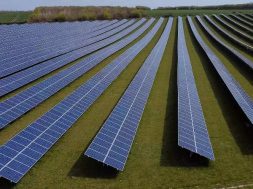
HomeEconomy Local manufacturers differ on anti-dumping duties on cells Local manufacturers differ on anti-dumping duties on cells
Current solar cell manufacturing capacity in India is 3.2 MW, while module-making capacity is about 8.5 GW.
Indian solar equipment manufacturers are closely evaluating the ongoing anti-dumping investigations against the import of solar cells from China, Taiwan and Malaysia initiated by the commerce ministry in July. Though they unanimously agree that anti-dumping duties (ADD) would help them strengthen their position in the Indian market, the industry players have different expectations on the implementation of the ADD regime in India.
Chinese solar modules are 8-10% cheaper than their Indian counterparts. The country imported about $3.2 billion worth of solar photovoltaic cells in FY17, which was 36% more than FY16. Of this, 88% and 7% were imported from China and Malaysia, respectively. The share of Chinese imports has doubled in five years. About 88% of all module requirement in India is met through imports (84% from China). Solar cells are the basic ingredient used in the manufacturing of solar modules.
Vikram Solar, the company with 1-GW solar module manufacturing capacity and the second-largest Indian manufacturer by revenue, believes that if anti-dumping mandates are passed on imported solar cells after the investigation, it will affect local manufacturers as currently cell-manufacturing capacity in India is very low, compared with solar module-making capacity.
“A large chunk of modules manufactured in India are dependent upon the imported cells,” Karunesh Chaturvedi, corporate affairs head, Vikram Solar, told FE. The current solar cell-manufacturing capacity in India is 3.2 MW and the module-making capacity is about 8.5 GW. However, the Indian Solar Manufacturing Association (ISMA) thinks that if the ADD is imposed the right way, the Indian cell-manufacturing capacity will increase to 7.5GW per year and module manufacturing capacity to over 10GW per year in 18 months.
ISMA claims that once a level playing field is provided to Indian cell and module manufacturers, there will be a sharp spurt of investments in Indian manufacturing capacities and a vibrant ecosystem will develop in a short time. “Indian solar industry will cease to depend on imports and will be able to establish a significant manufacturing and technology base that will meet the domestic demand and become a significant exporter to global markets,” said Dhruv Sharma, governing council member, ISMA.
ISMA members represent 85% of the solar cell-manufacturing capacity and more than 56% of the module-making capacity in India. The conundrum regarding the expectations on the investigation results resonates with similar developments at the ongoing anti-trade investigation in the US. Suniva and SolarWorld, two companies with manufacturing bases in the US, have called for duties of 40 cents per watt power (Wp) on imported cells and floor price of 78 cents per Wp.
Another segment of the US solar industry is against such suggestions, claiming that this would cause the market to contract and result in job losses. The US International Trade Commission will have to submit its recommendation on the issue to President Donald Trump by November 13. Research firm Bridge to India noted that “as in the US, any trade barriers in India are likely to result in market uncertainty and downsizing, not ideal conditions for making new manufacturing investments in an industry facing global oversupply”.











